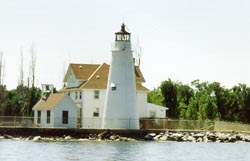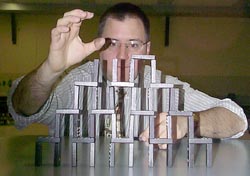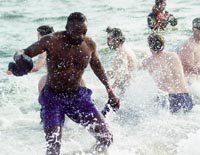At Calvert Marine Museum,
Lighthouse Lore Lures Hundreds
The lure of lighthouses drew hundreds to Calvert Marine Museum’s annual Winter Lights to learn of the trials, tribulations and triumphs of innumerable beacons.

By the 10am opening, vehicles sporting license plates from New Jersey, Delaware, Virginia and Maryland overflowed the small gravel parking lot.
Deep lines clogged the museum’s entrance. Clearly, lighthouses are on a roll.
Inside, lighthouse chapters, friends groups and Maryland Department of Natural Resources mounted huge displays. Picturesque information boards, books, pamphlets, T-shirts, sweatshirts, hats, lapel pins, candles and cookie cutters all bearing lighthouse logos were stacked atop tables staffed by zealous, story-telling enthusiasts. Hordes gathered close, monitoring each word as if it were the written Gospel.
They got their money’s worth in lighthouse lore.
“The Fishing Battery Lighthouse site once served as a birthing station for shad. The entire concept was far ahead of its time,” said Jack Davis, a volunteer at Havre de Grace Maritime Museum. “We’re raising funds for its restoration,” he added.
Havre de Grace boasts three lighthouses. The non-profit Chesapeake Heritage Conservancy ferries visitors to Concord Point, Fishing Battery and Turkey Point lighthouses aboard its skipjack Martha Lewis, which is a story in itself.
At St. Michael’s, the story is just as good. This chapter of lighthouse lore belongs to lighthouse automator Jay Fox, who volunteers at Chesapeake Maritime Museum.
“I was in the Coast Guard for 20 years working with lighthouses. When I retired I decided to use my expertise with Wallace and Tiernan, one of the largest lighthouse automators in the U.S,” said Fox.
“I only automated seven or eight of the Chesapeake lights but consulted on many others, and I’ve worked in 48 states and 52 countries,” Fox tallied. “People don’t realize how many lighthouses there are in the world.”
As the first shuttle bus left for Cove Point lighthouse promptly at 11am, the buzzing crowds shifted.
“We can only view the structures from the outside and look into the tower,” explained Ned Sprague, Calvert Marine Museum’s volunteer tour guide. “It’s been four years and we still don’t have control of the lighthouse. When it becomes ours, we will have everything open and the tour will be much nicer.”
Even behind a locked chain link fence, the buildings showed the stress of being unstaffed for a year. Shingles blanket the grounds, victims of the past week’s high winds, and graffiti smeared the wall of the smaller keeper’s house.
“The museum will have someone living here full time when we take over. That should put an end to this,” Sprague said.
Moving away from real lights, lighthouse lovers enjoyed artificial ones at the Gingerbread Lighthouse Contest.
Entries ranged from simple unfrosted cottage styles through meticulously iced lens-topped tower styles and tall caissons to a green Martian lighthouse.
By day’s end, lighthouse seekers, enthusiasts and inquisitors had savored and swallowed the lure of the lights.
Domino Theory: It Really Works
photo by Christopher Heagy World-class domino stacker Scott Suko.
It was a small topple. Just six cafeteria tables, a yardstick, a four-story pyramid, two swinging monkeys, a fiberglass staircase and 1,500 dominoes. The topple only took an hour and a half, maybe two hours to build. But after the first domino fell, those two hours of work were brought down in less than 30 seconds.

Construction and demolition were the work of world-class domino toppler Scott Suko, who brought his collection of 50,000 dominoes and his expertise to Odenton Elementary school last week to share his skill in a weekend class sponsored by Anne Arundel County Department of Parks and Recreation.
Eight students, from youngsters to middle age, came to watch and learn from the local domino dynamo.
By day an engineer, Suko says domino toppling combines two sides of his personality.
“I like to blend artistic creativity and engineering together,” said Suko.
This domino topple was just another in a long line for Suko.
He started putting dominoes up and watching them fall down in the late 1970s when he was a high schooler. The Hemophilia Association used topples as fund-raisers, and Suko lent a hand. Since, Suko has toppled dominoes in commercials for General Electric Information Services, Westinghouse, General Mills and Domino’s Pizza. A member of the Around the World Domino Toppling Team that was part of Coca-Cola’s centennial celebration in 1986, Suko is recognized as a world-class domino toppler.
He’s able, that means, to put very intricate designs and topples together.
“You have to be aware of a lot of things,” the toppler explained. “On large topples when you’re walking through a field of dominoes, you take up your pant cuffs to make sure they don’t brush a domino. Things get more and more tense the more dominoes are set.”
Suko showed his local students the basics of domino toppling: U-turns, side steps, branches and the pyramid design he invented. His largest pyramid ever is 14 stories.
But it all starts with set up designs. Grabbing a handful of dominoes, Suko spread them quickly, showing how to use tape and string to control when and where the dominoes fall. To beginning topplers, he offered this advice:
“The most important thing in setting up dominoes is patience. Small movements can knock the dominoes down and set you back. You can’t get frustrated. Patience and a steady hand are what you need.”
MLK Day:
How ‘We Shall Overcome’ Came to Be
Joe Glazer reflects on the history of “We Shall Overcome.”
Gather a couple thousand people in a room, as the 19th Annual Dr. Martin Luther King Jr. Memorial Breakfast did at Anne Arundel Community College this week, and you discover how rich a place Chesapeake Country is. Black and white, young and old, sprung from all corners of the world, we are diverse as the stars in the sky.
It’s the kind of gathering that would have gladdened Dr. King’s heart, had he lived to see it.
Seeing it yourself — lifted up by sweet, familiar chords of “We Shall Overcome” as all those people linked hands, sang and swayed — you could almost believe King’s dream had come true.
Which, according to Joe Glazer, is just how it ought to be.
Glazer couldn’t count how many times he’s sung “We Shall Overcome” since the 1940s. But the grey-haired, guitar-strumming folksinger can tell you where the song’s been those many years.
“It’s an old black gospel song,” he whispered over biscuits, bagels, bacon and eggs. As he recounted the song’s wanderings, the program of celebration began in earnest with Anne Arundel County’s highest achievers — Gov. Parris Glendening, Sen. Paul Sarbanes, Annapolis Mayor Dean Johnson, Board of Education president Paul Rudolph, Anne Arundel County schools superintendent Carol Parham, Anne Arundel Community College president Martha Smith — greeting, welcoming and politicking.
Soon we would be hearing the real people, the nine school children whose essays on the legacy of Dr. Martin Luther King Jr. were being honored by the Annapolis chapter of Links Inc. Five adults would be recognized for their work in continuing the tradition of Dr. King. From New York, the Rev. Dr. Wyatt Tee Walker would trace the rights movement.
But now Glazer is speaking quietly of roots. He borrowed the old gospel song, he told Bay Weekly, tailoring it to his work as a union organizer among textile workers in South Carolina. In his hands, the original words changed a bit. “I” became “we.” The second verse became “We will organize.” Eventually, “will” became “shall.”
“The textile workers were mostly white, and I had them singing ‘we shall organize’ as they walked the picket lines. I found that you could do more with music than with words alone,” he said.
The gospel song served his purpose well. “It’s short, simple and easy to remember. People don’t have to read music or study the words,” Glazer explained.
In the 1940s and ’50s, “We Shall Overcome” gained a second identity as a labor song. In the ’50s, Glazer was, he believes, the first to record the song.
“That was so long ago I did it on a 78rpm record,” said Glazer, who lives in Chevy Chase. He still writes songs, specializing in social change and politics. He helped Richard D’Amato win his seat in the Maryland House of Delegates two years ago with the song, “Get on the D’Amato train.” You can hear Glazer’s lilting voice singing Folk Songs of The American Dream on tape or CD.
He wasn’t alone in singing the song. Famed populist singer Pete Seeger sang it too, and so did Guy Carawan, another famed musician and voice for freedom. Its fame spread.
In the ’60s, the powerful little song took on another life. Picked up by the Civil Rights movement, it became the movement’s anthem. In the years since then, you’d have had to live on another planet not to have heard “We Shall Overcome.”
“It’s all over the world. I’ve sung it myself as far afield as Ireland and China,” said Glazer, tracing the simple song’s far-reaching pedigree. Traveling the world for the United States Information Agency in a second career, he sang it to show what was happening in the states.
“It’s a song that crosses all the lines.”
So here we are, in the year 2000, led by the son of immigrant Polish Jews, singing and swaying with linked hands to a black gospel song that traveled through the white labor movement on its way to the Civil Rights movement. Like the old song, we too have come a way.
—SOM
 Polar Plunge: Polar Plunge:
Water’s Fine for a Shivering Good Time
Last year, more than 1,000 people braved 39-degree Bay waters in the Polar Plunge, including, below, Nathaniel Knoll and Bay Weekly general manager Alex Knoll.
“It’s been a mild winter, so the water might be a little warmer. It’s usually between 36 and 38 degrees, but it might be 40 degrees this year,” lamented Polar Bear Plunge coordinator Dave Gell last week.
Now, Old Man Winter has finally made an appearance so the water might be a degree or two colder. Thirty-eight or 40: either way, that water is really cold.
If you’re ready to throw caution and your clothes to the wind, here’s your chance. Saturday, January 22, is the Fourth Annual Maryland State Police Polar Bear Plunge at Sandy Point State Park. At 2pm, 1,200 to 1,500 people will rush into the water to raise money for Special Olympics Maryland.
To join in the fun, each plunger needs to bring $50 in pledges. For this, the plunger receives a Polar Bear Plunge sweatshirt, a lunch from Outback Steakhouse, a group photo and the chance to be really, really cold.
Bay Weekly sends two plungers this year. General manager and veteran plunger J. Alex Knoll and young Chris Heagy will both wade into the water. With lofty fundraising goals in mind, Knoll has posted pledge sheets at local businesses and around the office. Meanwhile, Heagy is struggling, asking family, friends and even a few strangers — and you, reader — for those last few pledge dollars.
The two will join a thousand or so other plungers young to old, from bikers to police officers, in raising $200,000 for Special Olympics.
Registration begins at noon on the 2 2nd. All pledges are due the day of the plunge. So if you plan to spend a few cold minutes in the Bay, bring a towel, bring a friend and bring your money. 2nd. All pledges are due the day of the plunge. So if you plan to spend a few cold minutes in the Bay, bring a towel, bring a friend and bring your money.
One thing more.
“Wear a pair of old shoes when you go into the water,” Gell says, “and have a pair of shoes and warm socks to change into when you get out. You really feel the cold when you get out of the water.”
To learn more or to register, call 410/290-7611 ext. 5. You can also register on-line at www.somd.org or on the day of the plunge at Sandy Point.
Way Downstream …
In Virginia, Hanover County officials don’t appreciate Henry Broaddus’ method of protesting plans to dump treated sewage into the Pamunkey River. When Broaddus and his mother stationed several toilets on the edge of their farm to show displeasure, the county declared them “signs” that violated zoning rules …
Bethlehem, Pa., authorities are literally investigating brain drain. At a sewage treatment plant in Northampton County, they discovered half of a human brain, according to the Philadelphia Inquirer. Corner Zachary Lysek pronounced the grisly find “very perplexing … At the very least, the person who did this can be charged with improper disposal of medical waste” …
In Ohio, scientists think they’ve found a positive use for genetic engineering. Researchers at the University of Cincinnati have engineered firefly genes into zebrafish, which causes them to glow and therefore send out a signal when they come in contact with harmful PCB pollution in water …
In Florida, the Florida Marine Research Institute reported last week that boats killed more manatees than ever before. Of the 268 manatees that perished in Florida last year, 82 did so after being struck by watercraft. In 1998, 66 died from boats …
Our Creature Feature comes to us from Nebraska, where you’d better be alert if you’re short, hairy and wear a mask. State Sen. Jim Jones has introduced legislation that would allow people to shoot raccoons “on sight, at any time of the year” without a hunting license.
Jones’ bill has provoked a debate, with many Nebraskans not sharing the senator’s hostility to raccoons, especially those kept for pets. Cooler heads may prevail; the Omaha World-Herald is suggesting a population study before declaring open season on raccoons. If they pass this bill, we think they ought to study Nebraska’s one-chamber Legislature, too …
Copyright 2000
Bay Weekly
|